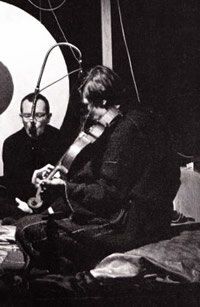

Promoting John Cale
New York in the 1960s promo sheet
This text was used for the promo sheet for the New York in the 1960s CD series in 2001.
What is haunting and disturbing about "minimal" music was the epidemic disruption it unleashed all up and down the cultural scale, a musical plague that seethed at every margin without discrimination as to class or social sophistication. Critics may try to "explain" minimalism as a high-class irruption, or a the contagion of "world music" imported from India and Africa; but there was a fire in the belly of the originators that the critics' feeble hand-wavings can't touch - a white heat that is still incendiary in independent imaginations.
In the early years the hunger for SOUND suddenly seemed to issue from every direction: Celtic piping, gagaku court music, 60 cycle hum- Tony Conrad found it in Bill Monroe and early Baroque composers, La Monte Young in shimmering telegraph lines and Indian ragas, Steve Reich in African drumming. Whatever their excuses, the musicians' actions spoke loudest in their dismantling of the dominant musical conventions. Classical music, already having sunk into elitism, was easily pushed over the brink. But it was to John Cale that it was left to break up the hegemony of commercial pop. By teaming with the VU, Cale mainlined the poison into rock.
While the VU was inventing Heroin, the radio was belching Mitch Ryder and the Detroit Wheels and Dorothy Springfield. The Velvets inhabited a parallel universe from platinum and gold vinyl, where they rebuilt rock and roll to incorporate SOUND. John's great credit was to have found the inoculation dosage that would addict the music industry to SOUND without alienating one world from the other. But outside the "official" VU there was also an uncut version of the virus, incubated behind the slum walls of the 1960's Lower East Side, and maintained live in the liquid nitrogen of these few insolently recorded reel to reel audiotapes.
The earliest recording in this collection is "Hot Scoria" recorded at 56 Ludlow Street, where the Velvet Underground was formed, with Angus Maclise playing cimbalom - a Rumanian instrument which Tony Conrad had bought on the Lower East Side, and which he gave to Angus after hearing him play it once.
Shortly after the Velvet Underground teamed up with Andy Warhol, Andy suggested that John compose a dance suite as part of a proposal to the Harkness Ballet Foundation. There was an abandoned piano in John and Lou's West 3rd Street flat above the fire station. John reduced this instrument to its frame, in the barren hope that the band could take it on the road, and fitted the skeletal remains with one of the crystal contact pickups then available for amplifying instruments. This is the "piano" heard in "(Untitled) for Piano", which was recorded as part of the Harkness proposal. "Big Apple Xpress" is also part of this unfinished ballet.
During the 1960's Cale frequently employed unusual and alternative instruments and performance techniques. The thunder machine heard in "(Untitled) for Piano","Big Apple Xpress" and "After the Locust" was a mechanical reverb unit crash produced by shaking or dropping the Vox Superbeatle amp head. Tony Conrad had introduced the "bouncing screwdriver handle" guitar technique used by John in his and Sterling Morrison's performance of "At about this time Mozart was dead and Joseph Conrad was sailing the seven seas learning English". This piece uses overdubbing in which the instant pause control, which was a feature of the Woolensak tape recorder, was used to "scratch" on a reel-to-reel tape. "Stainless Steel Gamelan" was performed live by John and Sterling, both playing on a single guitar. While Sterling played the fretless above the bridge, John produced percussion sounds on the short strings behind the bridge.
The electronic sounds of "The Second Fortress" and "Carousel" are actually generated on the Vox Continental organ, the same instrument that became a trademark of the Doors. In "Ex-Cathedra" John uses the deep vibrato of the Continental; in "The Second Fortress" he manipulates the draw bars over jammed keys in the upper register to build fluctuations of timbre. Most of the solo Continental recordings, and "After The Locust" were recorded at John and Betsey Johnson's apartment at 504 LaGuardia Place. Dream Interpretation was recorded in Tony Conrad and Beverly Grant's studio at 111 West 42nd Street.